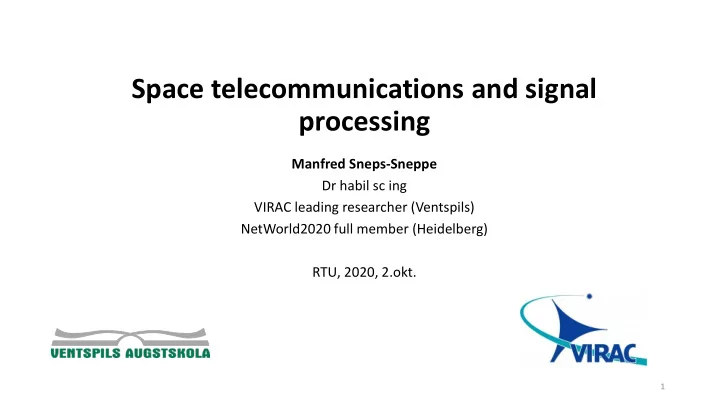

Space telecommunications and signal processing Manfred Sneps-Sneppe Dr habil sc ing VIRAC leading researcher (Ventspils) NetWorld2020 full member (Heidelberg) RTU, 2020, 2.okt. 1
The key goal - the re-equipment of radio telescopes RT-16 and RT-32 for space communications • S Band 2.025 - 2.3 GHz Space operations and research, including 'deep space' links from beyond Earth orbit. Unified S-band plan is used by many spacecraft, and was also used by the Apollo lunar missions. Many Earth resources (remote sensing) satellites downlink in this band. 2
Teleport “In Context” of U.S. Defense Information Systems Network DOD Teleport sites are globally-distributed SATCOM facilities. The system has six core Teleport facilities located in Virginia, Germany, Italy, Japan, Hawaii, and California, and three secondary facilities located in Bahrain, Australia (future), and Guam. 3
RADIO FREQUENCIES FOR SPACE COMMUNICATION 4
Presentation outline 1. Satellite communications 2. Nanosatellites 3. Signal processing (tutorial MatLab based) 4. VIRAC perspectives: • NetWorld2020 - European Technology Platform • European Space Agency: Satellite Communications 5
1. Satellite communications schema 6
DVB-S2 features A flexible input stream adapter, suitable for operation with single and multiple input streams of various formats ( packetized or continuous ); A powerful FEC ( Forward Error Correction) system based on LDPC (Low-Density Parity Check) codes concatenated with BCH (Bose-Chaudhuri-Hocquenghem) codes, allowing Quasi-Error-Free operation at about 0,7 dB to 1 dB from the Shannon limit; A wide range of code rates (from 1/4 up to 9/10); 4 constellations , ranging in spectrum efficiency from 2 bit/s/Hz to 5 bit/s/Hz; A set of three spectrum shapes with roll-off factors 0,35, 0,25 and 0,20 ; Adaptive Coding and Modulation (ACM) functionality, optimizing channel coding and modulation on a frame-by-frame basis. 7
Functional block diagram of the DVB-S2 System (single stream) 8
Bit mapping into signal constellation Each FECFRAME (which is a sequence of 64 800 bits for normal FECFRAME, or 16 200 bits for short FECFRAME), shall be serial-to-parallel converted (2 for QPSK, 3 for 8PSK, 4 for 16APSK, 5 for 32APSK) 9
Shannon limit and DVB-S2 decoded results 10
DVB-S2 adaptive coding and modulation 11
2. Satellite classification 12
Nanosatellites: CubeSat standard CubeSats are small satellite multiples of 1 U (1 U: 10 cm × 10 cm × 11.35 cm, weighing less than 1.33 kg), including all the basic subsystems as large satellites but using COTS components. 13
The number of nanosatellites launched per year 14
Venta-1 Venta-1 is Latvia's first artificial satellite to be launched into polar orbit on June 23, 2017. It is intended for testing of Automatic Traffic Identification Systems (AIS), communications between satellites and imaging cameras. The project was led by Ventspils University College, involving the German company OHB-System AG, Bremen University College and Ventspils High Technology Park. Venta-1 presentation 31 aug 2011. 15
Dutch space company Hiber orbital constellation of CubeSats Dutch space-based Internet of Things (IoT) startup Hiber is building an orbital constellation of CubeSats to provide global low-cost connectivity for the ‘Internet of Things’. Hiber received an undisclosed share of a €278 million European Innovation Council Accelerator grant as well as direct equity investment. Founded in 2016, Hiber employs over 50 individuals and aims to build and launch a IoT constellation of 48 satellites. 16
3. Signal processing theory (tutorial MatLab based) spectral representation sampled signals, complex signals, information transmission using orthogonal sine waves, modulations, See: papers by E. Tikhonov and M. Sneps-Sneppe spectrum modifications In “International Journal of Open Information Technologies” (like Direct Sequence Spread vol. 7, no.3, no.4, and no.7, 2019; vol. 8, no.6, 2020 Spectrum, etc.) 17
Statistical satellite signal processing (tutorial) Adaptive Coding and Modulation (ACM) functionality, optimizing channel coding and modulation on a frame-by-frame basis PLFRAMEs changing protection during a rain fading 18
4. VIRAC perspectives: NetWorld2020 NetWorld2020 - European Technology Platform for communications networks and services The NetWorld2020 Currently 1045 members ( representing 5 % of European GDP) The e hea ead q quarter er – EURESCOM OM ( (Hei eidelberg) g) 19
Eurescom Eurescom is a private organisation for managing European research and development projects in telecommunications. Eurescom is based in Heidelberg, Germany, and currently has 16 network operators as members performing collaborative research and development. 20
Megatrends of Future Networks (Political, Economic, Social, Technological, Legal and Environmental) 21
Fraunhofer Institute for Open Communication Systems (FOKUS) With 500 employees the Fraunhofer Institute for Open Communication Systems (FOKUS) is one of the largest Fraunhofer institutes. FOKUS develops urban IT infrastructures and counsels industry, public administration and organisations in the conceptualisation of complete IT strategies, the selection, engineering and deployment of appropriate solutions as well as the drafting of legislation in the IT context. The 10 competence centers at FOKUS are designed to cover the complete chain of development of urban IT infrastructures. This enables the digital governance and ensures that critical infrastructures such as traffic, power supply and medical help continue to function reliably and secure, round-the-clock. 22
VIRAC perspectives: European Space Agency (ESA) The Directorate of Telecommunications and Integrated Applications (TIA) is the most business-oriented part of ESA. This is achieved through ESA’s programme of Advanced Research in Telecommunications Systems (ARTES). Three priorities in the 2020-22 programme: Space for 5G , which aims to integrate satellite telecommunications with terrestrial. Space Systems for Safety and Security (“4S”) , which aims to develop secure satellite communications. Optical Communications – ScyLight , which aims to ESTEC: develop and demonstrate optical communication ESA's Space Research and Technology Centre technology for satellites. Noordwijk, Netherlands 23
Thank you for your attention! 24
Recommend
More recommend